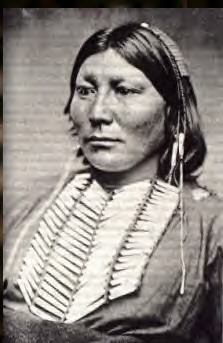White Horse (Kiowa leader) facts for kids
White Horse (whose Kiowa name was Tsen-tainte) was an important leader of the Kiowa people. He was born around 1840 or 1845 and passed away in 1892. White Horse was known for being a strong leader and a skilled warrior.
He attended a big meeting in 1867 at Medicine Lodge, Kansas. This meeting was between the United States government and several Native American tribes from the southern plains. It led to the signing of the Medicine Lodge Treaty. Even after signing the treaty, White Horse continued to lead raids. He often worked with other young Kiowa war leaders, like Big Tree.
Contents
Early Actions of White Horse
In 1867, White Horse joined a group of Comanches and Kiowas. They went on a mission to get revenge against the Navajos. At that time, the Navajos were living on a reservation near Fort Sumner, New Mexico.
Raids in 1870
White Horse led several actions in 1870. On June 12, he led a group to attack Fort Sill in Indian Territory. They managed to take seventy-three mules from the fort.
A few days later, on June 22, White Horse's group attacked a cattle drive. This happened on the famous Chisolm Trail. There was a conflict where some people were hurt before soldiers arrived and made the group leave.
Actions in Texas
On July 9, 1870, Kiowa warriors led by White Horse went into Montague County, Texas. They scattered a herd of cattle and took nine horses and one mule. They also took supplies, a tent, and a wagon cover. All of these items belonged to Colonel Samuel Newitt Wood.
Another event happened on August 7, 1870, also in Montague County. During this time, a farmer named Gottlieb Koozer was killed. His wife and five children were taken captive, along with a fourteen-year-old boy named Martin Kilgore. Later, a Quaker agent named Lawrie Tatum helped to get the family back. He arranged for them to be returned safely.
White Horse was also involved in the Warren Wagon Train raid. This event took place on May 11, 1871, in Texas. Other important Kiowa leaders like Satank and Satanta were also part of this event.
Battle at Howard Wells
On April 20, 1872, White Horse and another leader named Zepko-ete led about one hundred Kiowa and Comanche warriors. They attacked a government wagon train at Howard Wells station. This station was along the San Antonio - El Paso trail. During the fight, many people were killed, and a woman was taken captive.
Two groups of soldiers from the 9th Cavalry arrived from Fort Clark. These soldiers were known as "Buffalo Soldiers." They fought against the Native American warriors. The soldiers had to retreat after some of their own were hurt. Reports said that ten warriors were killed in these fights.
Later Life and Art
After a big battle called Adobe Walls in June 1874, White Horse joined other leaders. He fought alongside Guipago and the Comanche leader Quanah Parker in the Red River War. The fighting continued until April 19, 1875. On that day, White Horse and his group surrendered at Fort Sill.
When General Philip Sheridan decided which tribal members would be sent to prison in the east, White Horse was chosen. He was picked by the Kiowa leader Kicking Bird. White Horse was sent to Fort Marion in St. Augustine, Florida. He was imprisoned there with other Kiowa, Comanche, Caddo, Cheyenne, and Arapaho people.
While at Fort Marion, White Horse became an artist. He was one of the prisoners who created what is now called Ledger art. This art was drawn in old ledger books, which were like accounting notebooks.
In 1878, White Horse and the other Kiowa prisoners were allowed to return. They went back to the reservation in Indian Territory, near Fort Sill.



